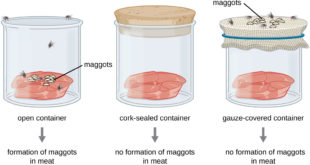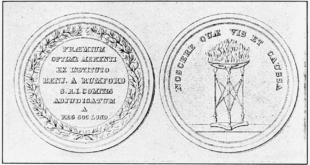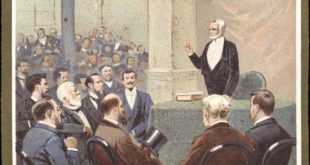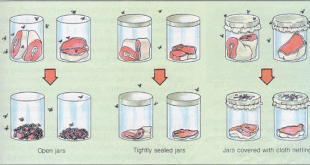Originally published in The American Naturalist, Vol. 10, No. 12, Dec. 1876, pp. 730-734
by Henry J. Slack
In the number of Comptes rendus for July 10, 1876, is a paper by Dr. Bastian, On the Influence of Physico-Chemical Forces in the Phenomenon of Fermentation, intended to demonstrate, in opposition to the theory of atmospheric germs, that certain organic liquids contain complex chemical bodies which are capable of organization, and form different kinds of bacteria.
In support of these notions he recites experiments on urine caused to boil and screened from the influence of atmospheric germs. To determine the production of bacteria in this urine he introduced potash and oxygen, and subjected it to 122°F. He states that in numerous trials, urine previously rendered sterile and heated as just stated gave rise to bacteria. He found that a temperature of 122°F., though not generally considered favorable to fermentation, was to the development of bacteria in urine and some other organic liquids.
In the autumn of 1875, he says, he found that urine, normal and acid, rendered sterile by ebullition, became fertile in two or three days when exactly saturated by potash, without other contamination, and after being exposed to an elevated temperature. He further states that he took the most minute precautions to avoid the influence of germs that might have been in the potash or on the walls of the vessels employed, s well as those which the air might carry.
He also states, with regard to the influence of oxygen, that urine rendered sterile, neutralized by potash, and subjected to electric action through platinum wires, gave remarkable results, fermenting rapidly at 122°, and becoming filled with bacteria in from seven to twelve hours. He considers that these experiments overthrow the atmospheric-germ theory, and cites Tyndall to the effect that bacteria germs are destroyed by a temperature of 212° maintained for a minute or two, as was the case with the fluids he used.
In the Comptes rendus for July 17th, M. Pasteur makes a very polite reply, tinged with a little irony, in the remark that the heterogenists are more fortunate than the inventors of perpetual motion, in the lengthy attention they have receive from scientific bodies. In the domain of mathematical sciences it is, he says, possible to demonstrate that certain propositions cannot be true, but natural sciences are less able to predict results. The mathematician may disdain to cast his eye upon an essay which has for its object squaring the circle, or perpetual motion; but the question of spontaneous generation excites public opinion, because it is impossible in the actual state of science to prove a priori that no manifestation of life can take place by a jump, without the previous existence of similar life.
When any observer announces that he has discovered the conditions capable of causing the spontaneous origin of life, he is sure of the prompt adhesion of the systematic supporters of his doctrine, and of raising a doubt in the minds of others, who have acquired only a superficial knowledge of the subject. This is the more the case when an author, like Dr. Bastian, occupies an important position, has literary and dialectic talent, and brings forward conscientious researches.
During the twenty years he has worked at this question, M. Pasteur says he has not been able to discover any life not preceded by a similar life. The consequences of such a discovery would be incalculable. Natural sciences in general, medicine and philosophy in particular, would receive an impulse of which no one could foresee the consequences, and if any one succeeds in reaching such a result, he would welcome the happy investigator on his operations being proved. At present his attitude is one of defiance, as he so often show how readily able men make mistakes in this difficult art of experimentation, and what danger is connected with the interpretation of facts.
Let us see, he exclaims, whether Dr. Bastian has known how to escape these two rocks. He then cites the title of Dr. Bastian’s paper and his chief remarks, and adds that he hastens to declare that the experiments described would usually give the results that are stated, and that he need not have operated at a temperature of 50°C., as at 25° or 30°, and even lower, boiled urine rendered alkaline by potash in a pure atmosphere becomes filled with bacteria and other organisms. If Tyndall, as Dr. Bastian says, thought this was not so, it must have been through forgetfulness. Dr Bastian cannot be unaware that the experiments he has just communicated to the academy, or at least experiments of the same kind, were made by me, and published in a memoir in 1862, entitle On Organic Corpuscles which exist in the Atmosphere: and Examination of the Doctrine of Spontaneous Generation. I demonstrated in this paper (pages 58,66) that acid liquids which always become sterile by a few minutes’ exposure to 100°C. are made fecund if we communicate to them a slight alkalinity. The novelty introduced by Dr. Bastian in having recourse to a temperature of 50°C. is only apparent, since this condition is superfluous. There is, then, between us only a difference in the interpretation of facts common to both. Dr. Bastian says these facts prove spontaneous generation, and I reply, Not at all; they only demonstrate that certain germs of inferior organisms resist a temperature of 100°C. in neutral and slightly alkaline solutions, doubtless because under such conditions their envelopes are not penetrated by the water, and that they are so if the medium in which they are heated is slightly acid. In reference to this I will recall that the workmen of Rouen, as M. Pouchet informed us, noticed that certain seeds attached to wool coming from Brazil germinated after four hours’ exposure to boiling water, and M. Pouchet proved that when the germination occurred after such treatment the grains had preserved their natural size, their hard, horny envelope not having been penetrated by water or steam; when the contrary was the case, germination was impossible. With regard to germs disseminate in atmospheric dust, I proved that they perished in an acid medium at 100° C., but they remain fertile if the medium is alkaline. (See page 65 of my paper.)
“If Dr. Bastian wishes to assure himself of his errors of interpretation, he can easily do it. He obtains bacteria by saturating boiled urine with potash. I simply suggest that instead of employing an aqueous solution of potash, he should drop into the urine solid potash after making it red-hot, or even only to 100° C. His experiment will then never success; that is, he will obtain no formation of bacteria in urine exposed to 30°, 40°, or 50° C. The conclusion he has drawn from our common experiments is thus inadmissible, for it would be absurd to pretend that the primum movens of life is in melted caustic potash. Such is the way of obtaining a decisive results. In one word, I only ask Dr. Bastian to eliminate the bacteria germs which were contained int he aqueous solution of potash he employs. If Dr. Bastian finds it difficult from the apparatus he uses, and does not describe, to bring the potash to a red heat previous to cooling it and dropping it as a solid into the urine, let him, instead of heating it to 100° C., heat it to 110° C., and he will then find sterility if he operates with vigorous accuracy. If he still preserves his doubts, let him suppress the preliminary condition of causing the urine to boil for it is a remarkable fact that urine in its absolutely normal states as it leaves the bladder of a healthy man remains sterile if a certain quantity of potash is dropped into it, with the precautions I have described in chapter iii. of my recent work on beer, to avoid contact with atmospheric germs. Dr. Bastian conscientiously seeks the truth, and no alternative conclusion is possible. I entertain the firm hope that he will abandon his belief in spontaneous generation and in the proofs he supposes he has adduced.”
M. Pasteur at the close of his paper state verbally that, although the urine of a health many contains no extraneous germs or organic bodies, in most cases it comes into contact with such germs at the moment of its emission at the extremity of the urethral canal, or in the surrounding air. He also described the very simple apparatus he employed to repeat Dr. Bastian’s experiments with decisive results. It is a pity that no details of this are given in Comptes rendus.
Dr. Bastian’s reply to Pasteur’s criticism, and the latter’s rejoinder, will be found in Comptes rendus for July 31st and August 7th, they add nothing to the preceding.
 Pasteur Brewing Louis Pasteur – Science, Health, and Brewing
Pasteur Brewing Louis Pasteur – Science, Health, and Brewing 


